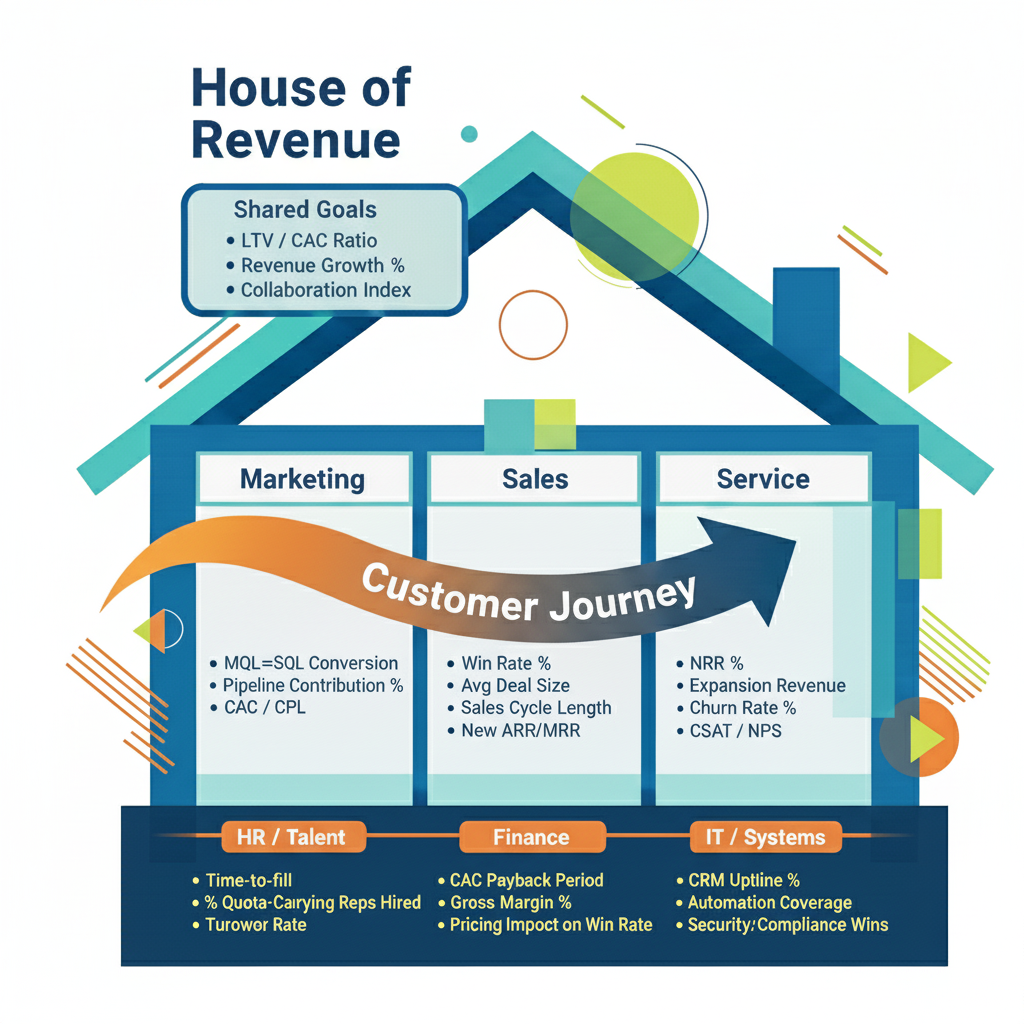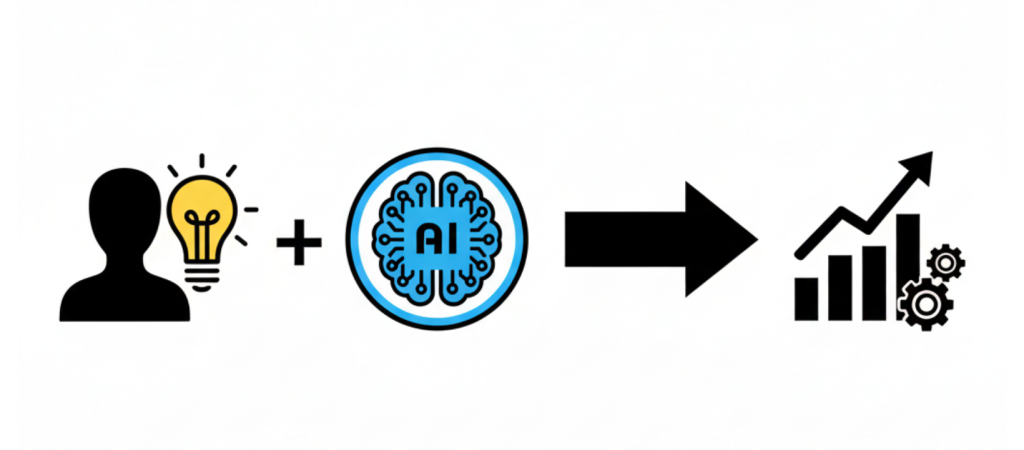The House of Revenue:
Why Startups and SMBs Must Focus on People, Not Just Tools
I’ll admit it: I’m a sales guy. And like many sales folks, I could spend a whole blog poking fun at marketing – the 14,000-logo MarTech supergraphics, the alphabet soup of platforms, the endless campaigns that somehow always need “just one more tool.”

But here’s the truth: tool sprawl isn’t just a marketing problem anymore. It’s an enterprise problem for startups and SMBs.
Sales has its own stack. Customer Success has a stack. HR, Finance, and IT have stacks. If you drew every tool across the whole company, you’d have a zoo of logos that makes the MarTech map look tame.
And let’s be clear up front: if there were just one metric that matters most for startups and SMBs at any stage, it’s revenue growth. Everything else—tools, headcount, valuations—rolls up into the question: Are you growing revenue productively, focusing on efficiency and effectiveness?
So, let’s not pick on marketing (too much). Instead, let’s talk about the bigger issue: how startups and SMBs can stop drowning in tools and start building something sustainable.
The answer? The House of Revenue.

From Stacks to a House
The “stack” metaphor has had its day. Sales stack. Marketing stack. Tech stack. All are useful in their own way, but they reinforce silos.
What we need is a structure where all functions work together – front office and back office, connected by shared goals.
- Front Office (the walls & windows): Marketing, Sales, and Customer Success – what customers see and interact with.
- Back Office (the foundation): HR, Finance, IT – often invisible, but if the foundation cracks, the house collapses.
- Shared Goals (the roofline): Revenue growth %, LTV/CAC, Retention, Efficiency – the beams that keeps everything intact.
- RevOps (the framing & wiring): The connective tissue that aligns all functions – front and back – so the house operates as one.
People Before Platforms
Here’s the shift founders need to embrace: tools don’t build revenue houses, people do.
- A CRM without reps logging quality data is just an address book.
- A customer success platform without humans building relationships is just a ticketing system.
- Finance software without analysts or FP&A discipline is just a bunch of numbers.
AI and automation amplify what’s already there. They can make people faster, sharper, more productive. But they can’t replace:
- Empathy in customer conversations.
- Judgment in pricing, hiring, and budgeting.
- Accountability across teams.
AI + people is the equation that works. Without people-first processes, AI is just shiny scaffolding around an empty house.
The U.S. Talent Reality
Now here’s where it gets real for U.S.-based startups and SMBs: talent is harder to find, takes longer to hire, and costs more than ever.
- Average time-to-fill for skilled roles is now 44+ days (BLS, 2025). That’s an eternity for a startup burning cash.
- Median tech salaries in many U.S. markets are now above $100,000/year, and for specialized or senior roles often reach $120,000–$150,000+. When you factor in benefits, taxes, and overhead, one such hire can easily eat a big slice of early-stage startup budgets. (BLS, 2025)
- And when you finally do land a candidate? Competition for retention is fierce. Enterprises can outbid you.
This is why more startups are looking beyond their zip code for help.
Outsourcing & Offshoring as a Strategic Lever
This isn’t about “cheap labor.” It’s about flexibility, scalability, and sustainability.
- HR/Talent: Offshore pipelines let you fill roles faster.
- Finance: Offshore analysts cut the cost of forecasting and reporting.
- IT: Offshore IT and DevOps provide 24/7 uptime and compliance.
- Marketing, Sales, CS: Nearshore/offshore support gives you coverage, capacity, and cost efficiency.
This is where firms like HeyBuddy Solutions fit in: people-first, AI-enabled operational scale.
We primarily support U.S.-based startups and SMBs. Why? Because that’s where the gap is widest:
- Talent is scarce.
- Hiring takes too long.
- When you finally find someone, you often can’t afford them.
We don’t sell tools. We deliver talent and hybrid offshore business models that flex with your growth.
RevOps: The Hidden Structure
Here’s where most startups get it wrong: they treat RevOps as just marketing ops + sales ops + CS ops. But the real power of RevOps is bigger – it’s the framing and wiring of the House of Revenue.
- Marketing Ops: Campaign attribution, lead scoring, CAC clarity.
- Sales Ops: Territory design, compensation models, forecasting.
- Customer Success Ops: Renewal metrics, expansion workflows, churn prediction.
- Finance Ops: Budget alignment, CAC payback, pricing strategy, revenue recognition.
- HR Ops: Hiring pipelines, onboarding, retention linked to revenue capacity.
- IT Ops: CRM uptime, automation coverage, compliance for enterprise deals.
RevOps doesn’t replace these ops – it orchestrates them. It ensures that metrics align, tools talk to each other, and every room in the house supports the same roofline.
The House of Revenue at Each Startup Stage
The House metaphor evolves as your startup matures. RevOps is the guiding framework across each stage.
Early Stage (Seed to Series A)
- Challenge: Founders juggle everything. No dedicated back office. Burn is high.
- House: Foundation is thin – HR, Finance, IT are afterthoughts.
- Solution: Outsource/offshore foundational roles (recruiting, finance ops, IT support). Use lightweight RevOps to align basic metrics (CAC, runway, funnel health).
Mid Stage (Series B-C)
- Challenge: Growth is real, but cracks appear. Tool sprawl, delayed hiring, inconsistent metrics.
- House: Walls go up fast (Marketing, Sales, CS), but the foundation lags. Roof leaks when metrics don’t line up.
- Solution: Strengthen the foundation with offshore HR, Finance, and IT. Implement RevOps across all ops (not just sales/marketing) to unify reporting and processes.
Late Stage (Series D+)
- Challenge: Enterprise customers, compliance, investor pressure for efficiency.
- House: Big house, but expensive to maintain. Risk of collapse if foundation wasn’t built early.
- Solution: Blend AI + offshore/nearshore talent. Use RevOps to standardize global processes across regions and functions, making metrics board-ready.
SMBs
- Challenge: Compete with startups and enterprises for talent. Need enterprise-grade capability without enterprise costs.
- House: Solid, but modest house. Every room is stretched thin.
- Solution: Outsource/offshore back-office ops (HR, Finance, IT). Apply RevOps discipline lightly to align ops with revenue goals without overengineering.
Metrics That Hold the House Together
When RevOps aligns the house, metrics flow clearly:
- Foundation (HR, Finance, IT): Time-to-hire, CAC payback, CRM uptime, compliance pass rates.
- Front Office (Marketing, Sales, CS): MQL→SQL conversion, win rate, ARR growth, NRR, churn.
- Roofline (Shared Goals): LTV:CAC ratio, revenue growth %, retention, collaboration score.
RevOps makes sure every metric rolls up to the roofline.
AI vs Human: Co-Builders, Not Competitors
Yes, AI is transforming how startups operate. But let’s cut through the FUD: AI isn’t “killing” marketing, sales, customer success, or ops.
- AI writes, predicts, automates.
- Humans decide, empathize, persuade.
- RevOps connects them.

Together, they’re co-builders of the house. AI is the reinforcement. People are the builders. RevOps is the wiring that ensures the lights stay on.
Closing Thought
I started by saying I could pick on marketing, but the truth is, every function has its own zoo of logos. This isn’t a marketing problem. It’s an enterprise problem for startups and SMBs.
The solution isn’t more tools. It’s people-first models, AI-enabled workflows, and RevOps discipline to align every function around shared goals.
And here’s the kicker: startups at any stage; early, mid, late, or SMB, can benefit from thinking like an enterprise. Building your House of Revenue early means you won’t have to build it (or rebuild it) later.
What if you’re in the middle of raising funding?
This is actually the best time to show discipline. Investors don’t just want to see pipeline or growth projections – they want confidence that your house is structurally sound. Tighten your foundation by:
- Auditing your CAC, LTV, churn, and burn multiples.
- Demonstrating how back-office readiness (HR, Finance, IT) supports front-office scale.
- Showing how RevOps aligns your metrics into one story.
- Highlighting how your people/talent strategy (in-house + offshore + AI) makes every dollar more efficient.
Raising capital isn’t just about storytelling; it’s about proving that when new money comes in, your house won’t collapse under its own weight.
So, the real question is this:
As you scale, are you building a stack of tools… or are you building a House of Revenue – where people and talent form the foundation, RevOps ensures the walls and roof stand together, and AI acts as the reinforcement that helps it all grow stronger?
